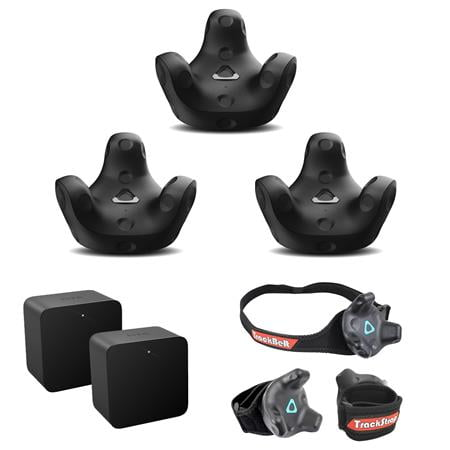Vive Trackers
What Are Vive Trackers?
Vive Trackers are small motion-tracking devices designed to bring real-world objects into virtual environments. While they are commonly used in VR setups to track body movements or props, they can also function as standalone tracking devices in software like TouchDesigner. Each tracker sends precise position and rotation data, making them useful for interactive installations, motion capture, and experimental media projects. By integrating them into creative software, we can map real-world movement onto digital visuals, audio, or other interactive elements.
Setting Up Vive Trackers with a Vive Pro & SteamVR
To use Vive Trackers standalone (without VR controllers), follow these steps:
1. Hardware Setup
A. Prepare Your Equipment
-
Vive Pro Headset (even if unused, SteamVR requires it to be connected)
-
Vive Trackers (paired via dongles or directly with the headset)
-
Base Stations (for tracking)
-
USB Dongles ( when using multiple trackers )
B. Position the Base Stations
-
Mount at least two base stations (2.0 recommended) above head height at opposite corners of your space, at a maximum of 5 meters apart.
-
Ensure they are powered and have a clear view of the area.
2. Install & Launch SteamVR
-
Install Steam and SteamVR if not already installed.
-
Connect the Vive Pro headset to ensure SteamVR initializes correctly.
3. Pair the Vive Trackers
-
Turn on each tracker by pressing the power button until the light turns blue.
-
Open SteamVR and go to Devices > Pair Controller (works for Trackers too).
-
Select "Vive Tracker" and follow the instructions.
-
If using a USB dongle, plug it into your PC and ensure the tracker is paired to it. Place the extension cradles at 45 cm from the computer for stable tracking.
-
Once paired, the tracker’s LED will turn green.
4. Configure the Trackers in SteamVR
-
Open SteamVR > Devices > Manage Vive Trackers
-
Set each tracker's role (e.g., “Held in Hand” or “Disabled” if using it just for positional data).
-
If needed, attach them to an object or a strap (e.g., for body tracking). This can be done with a camera-mount, ¼-inch screw size.
5. Use in TouchDesigner
-
Open TouchDesigner and use the OpenVR CHOP and set it to 'trackers' to read positional and rotational data.
-
Trackers send position (XYZ) and rotation (quaternion or Euler angles).
-
You can map this data to visuals, interactive elements, or other media.
6. Use in other software
- Use GazeboOsc to pick up the Tracker signals & send them to other software (e.g. Isadora) that can handle OSC.
Troubleshooting
- Check if the tracker has a uninterrupted line of vision with the base stations & headset.
-
If a tracker is not detected, reset it by holding the power button for 10 seconds.
-
Ensure no reflective surfaces interfere with the base stations.
-
Restart SteamVR if tracking is unstable.

